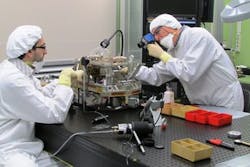UV laser for ESA wind lidar space mission passes 90-million-shot test
Rome, Italy--A diode-pumped frequency-tripled pulsed Nd:YAG laser transmitter developed by Selex-ES has passed a three-week test during which it was run at 50 Hz, a total of 90 million shots. The laser, which emits 150 mJ pulses at 355 nm, remained stable at full energy. The laser is part of a future European Space Agency (ESA) satellite-based wind-sensing system called Aeolus.
Related: 10 GHz radiation-hardened photodiode to fly on satellite lidar
Related: Northrop Grumman and SELEX Galileo pursue international DIRCM market
Related: Record high power diode-pumped alexandrite laser demonstrated by Midaz for ESA
The Aeolus satellite will carry a single instrument called Aladin that will probe the atmosphere to profile the world’s winds. Reliable and timely wind profiles are urgently needed by meteorologists to improve weather forecasts. In the long term, they will also contribute to climate research. Aladin will rely on laser light scattering back to the satellite from Earth and the Doppler effect to gather wind data.
The laser generates high-energy UV light, which is beamed towards Earth through a telescope. As the light travels down through the atmosphere, it bounces off molecules of gas, particles of dust and droplets of water.
Difficult undertaking
According to the Aeolus mission, the technical development has been a very long and difficult undertaking in many areas such as optics, optoelectronics, precision mechanics, and thermomechanical design. “Bearing in mind the hurdles we’ve faced, this positive outcome is very important," says Alessandro d’Ottavi, the chief laser engineer at Selex-ES. "The environment in space, the high laser power, and the number of laser shots that the UV optics will have to withstand over the life of the mission all mean that the Aladin UV optics had to be pushed beyond the state of the art.”
Didier Morancais, project manager for the Aladin instrument at Astrium-SAS (Suresnes, France), adds, “This project has been on the brink of technology from the start. These positive results, together with added design margins within the laser and the instrument, are encouraging and pave the way towards a qualification of the first UV space laser.”

John Wallace | Senior Technical Editor (1998-2022)
John Wallace was with Laser Focus World for nearly 25 years, retiring in late June 2022. He obtained a bachelor's degree in mechanical engineering and physics at Rutgers University and a master's in optical engineering at the University of Rochester. Before becoming an editor, John worked as an engineer at RCA, Exxon, Eastman Kodak, and GCA Corporation.
